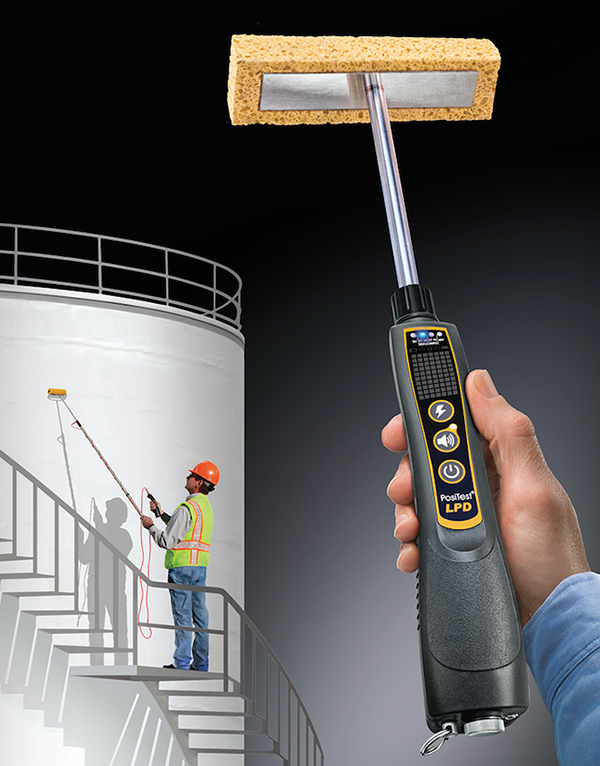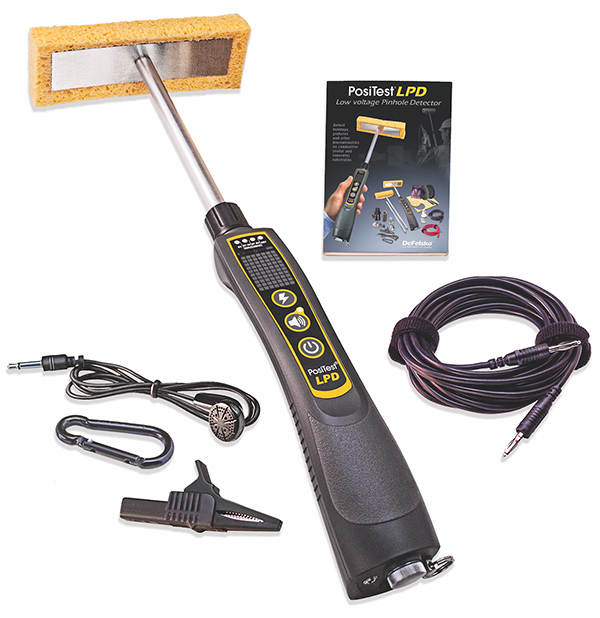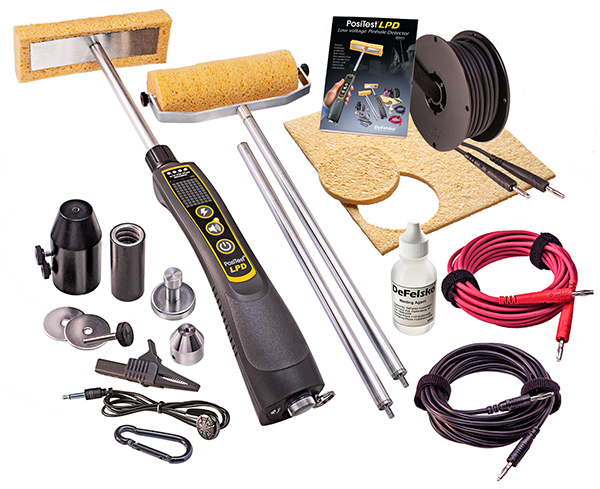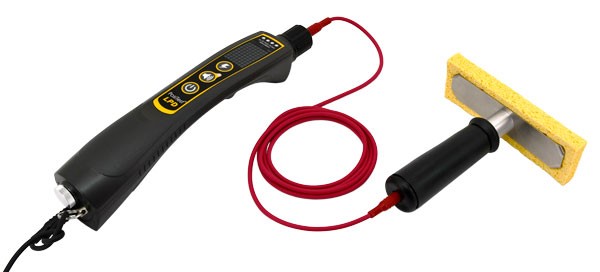PosiTest LPD - Low Voltage Pinhole Detector
 DeFelsko's PosiTest LPD is the smartest and most ergonomic pinhole detector available, it weighs less than other products and offer unique features that ensure correct operation and reliable performance. These features include GroundSenseTM to ensure the electronic circuit is correctly connected and calibrated voltage outputs.
DeFelsko's PosiTest LPD is the smartest and most ergonomic pinhole detector available, it weighs less than other products and offer unique features that ensure correct operation and reliable performance. These features include GroundSenseTM to ensure the electronic circuit is correctly connected and calibrated voltage outputs.
A pinhole detector is an electronic test system for detecting discontinuities in a coating system including pinholes, cracks and thin spots. Other names include porosity detector, continuity tester, sponge tester and holiday detector.
After a protective coating has been applied, it is important to ensure there are no defects or discontinuities present that expose the substrate beneath. Small areas of thin or missing coating, called 'pinholes' or 'holidays', can become foci for corrosion and drastically reduce the life of a protective coating system. They can be invisible to the naked eye.
Porosity detectors are often used in applications where corrosion is difficult to monitor, or in aggressive service environments where performance of the protective coating is critical.
There are two types of pinhole detectors, low voltage (wet sponge) and high voltage (spark tester). Low voltage detectors, like the PosiTest LPD, are typically used on coating systems less than 500 µm (20 mils) thick.
Features
- Easy-to-use interface with bright, multi-function LEDs
- Audibly and visibly alerts when flaws are detected
- Weatherproof, dustproof and shockproof — meets or exceeds IP65
- Automatic self-test verifies voltage calibration
- Regulated voltage outputs will not drop under load
- GroundSenseTM visibly reassures the user that the instrument is properly grounded
- Common threads and connectors allow for maximum flexibility
- Headphone jack with included earbud for noisy environments
Theory
A low-voltage pinhole test is performed by moving a moistened, electrified sponge over a non-conductive coating applied to a conductive substrate. The instrument is 'grounded' or 'earthed' to the conductive substrate, typically by clamping onto an uncoated area.
When the coating is continuous and no defects are present, electronic current is unable to pass from the sponge to the substrate through the non-conductive coating. But when the electrified sponge encounters a flaw in the coating, electricity is able to flow into the substrate and travel back to the instrument through the ground wire, completing the circuit and setting off the audible and visible alarms.
Testing over Concrete
Concrete is still slightly conductive, and can carry enough current to allow low-voltage pinhole detectors to function, so concrete is considered a 'conductive' substrate for low voltage pinhole testing only. When measuring coating thickness with tools such as the Positector 6000, concrete is not considered a 'conductive' substrate, as it is much less conductive than metal.
The challenge when conducting low-voltage pinhole testing on concrete is to ensure the instrument is properly grounded. If there is exposed rebar or metal protruding from the concrete, this is the easiest solution. An alternative is to drive a metal rod (or piece of rebar) into the ground nearby the concrete to at least the depth of the slab, relying on the earth to conduct the electric current between the rod and the slab.
Test Kit and Accessories
The PosiTest LPD can be supplied as a Basic or Complete kit, the contents of which are listed below. There is also a range of spares and calibration tools available:
 PosiTest LPD Basic
PosiTest LPD Basic
Includes everything needed for detecting pinholes using a rectangular sponge
Basic Kit comes complete with PosiTest LPD, base tube, 3 AAA batteries, rectangle sponge hardware, rectangle sponge, 4.5 m (15') ground wire, insulating collar, ear bud, wrist strap, carabiner, Long Form Certificate of Calibration traceable to NIST, instructions, hard shell case, two year warranty
PosiTest LPD Complete
 Includes contents of the Basic Kit, plus adaptable sponge hardware and extension hardware in a hard-shell case.
Includes contents of the Basic Kit, plus adaptable sponge hardware and extension hardware in a hard-shell case.
Adaptable Sponge Hardware
- Rectangle (Flat)
- Roller
- Circle jig for internal testing of pipes and conduits
- Additional 20 cm x 20 cm (8" x 8") sheet sponge for custom usages
- Wetting agent
Extension Hardware
- Extension rods provide an additional 0.6 m (2') of reach
- Universal adapters to extend existing paint rollers and poles
- 12 m (40') ground wire
- 4.5 m (15') hot wire
- Magnetic grounding post
Available Accessories 
- Conversion - Cabled Wand
- Replacement Sponges [Rectangle, Roller or Sheet Sponge]
- Extension Rod 0.3 m
- Wetting Agent
- Sometimes pinholes are so miniscule that water has difficulty reaching the conductive substrate underneath, especially on thicker coatings when the water must penetrate further into a pinhole to reach the substrate. In these instances, inspectors will use a surfactant (wetting agent) to lower the surface tension of the water, allowing the solution to better penetrate the pinhole.
- PosiTest LPD Verifier
Specifications
| # | Make | Model | Year | Price |
| 1 | Honda | Accord | 2009 | $12000 |
| 2 | Toyota | |||
| 3 | Hyundai | |||
| 4 | Honda | |||
| 5 | Toyota | |||
| 6 | Hyundai | Elantra | 2010 | $22000 |
| 7 | Honda | Accord | 2009 | $12000 |
| 8 | Toyota | Camry | 2012 | $14900 |




